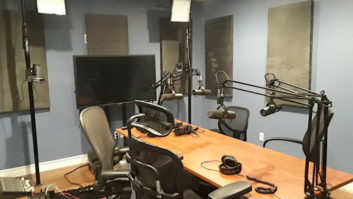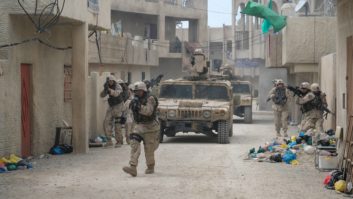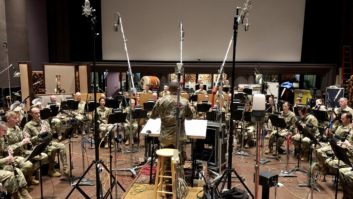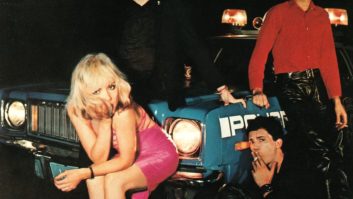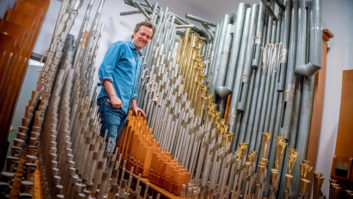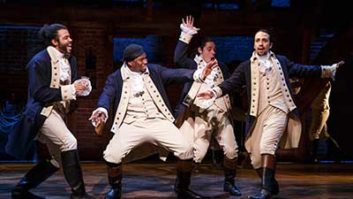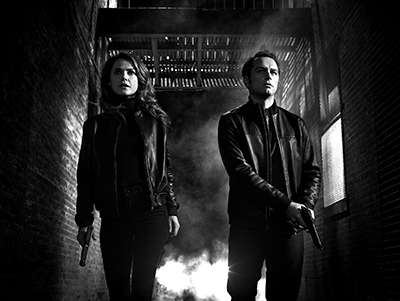
The Soviet spies of FX’s The Americans run a Washington, D.C., travel agency, kill to protect the interests of the Soviet Union, raise two children, flatten all opponents in hand-to-hand combat, and don wild wigs to impersonate C.I.A. agents and a host of others—all in a day’s work.
It’s great, outlandish entertainment with a serious core, but it creates a lot of disbelief to suspend. That’s a tall order, especially on a basic-cable budget.
Lead mixer and co-supervising sound editor Ken Hahn, co-producer David Woods and their team skillfully use sound design to bolster the believability of these spies hiding in plain sight in suburbia. (All three seasons of the show have been mixed at New York City’s Sync Sound, owned by Hahn and partner Bill Marino.)
The Americans (called the best show on television by Rolling Stone, The Washington Post and others) was inspired by the 2010 arrest of Russian spies living as Americans. But these agents were said to be soft, unimpressive and fighting a war that seemed long over.
Not exactly exciting material for a TV series.
The producers upped the dramatic ante—and their production challenges—by setting The Americans in the early 1980s, when Ronald Reagan is President, hot and Cold Wars rage, and the daily struggle is life and death for the Directorate S Soviet agents.
While The Americans is a period show, “It’s so recent it does it not always feel like period; we were alive then and the audience remembers it, as they do not remember World War II or Prohibition,” says co-producer Woods, noting that this makes it somewhat harder to portray the period convincingly.
But The Americans is not only a series out of time; it is also out of place.
The show is set in the Washington D.C./Falls Church, Va., area but shot around New York City, and the New York and D.C. areas look nothing alike. (D.C. gets little snow; The Americans was shot during two of the snowiest winters in New York’s history.)
So The Americans needs all the help it can get in making a wild, period adventure story—set amid historical events in a recognizable world—believable.
Sound design needs to do some heavy lifting to keep the audience involved in The Americans’ fantastic fictional universe. And it does.
Key elements of the world of spies Philip and Elizabeth Jennings (Matthew Rhys and Keri Russell) and the FBI agents hot on their trail are the communications devices of the early 1980s. The plots are often driven by news broadcasts and moved further along by an array of overt and covert communications devices. Episodes are filled with sounds from all sorts of low-fi speakers.
The design team nails these sounds: everything from the scratchy, quivering shortwave radios with which the Jennings get encoded orders from Moscow to audiocassette letters sent secretly to Elizabeth by her mother from the Soviet Union. We also hear (and see) period audio-bugging devices.

These thin little sounds do a lot to help sell the time period and bolster the milieu.
Philip and Elizabeth frequently listen to a robotic voice reading a series of numbers over their shortwave radio (unbreakable coded orders, deciphered with a one-time pad). These distant, fragmented and chillingly disembodied voices sound like they could be coming from deep inside of Moscow Centre.
When we hear Elizabeth’s mother’s sad voice on a cassette letter, the sound is so fluttery and barely above the noise floor one can easily believe she was hunched over a Soviet-made cassette recorder somewhere deep in the U.S.S.R. The disturbingly evocative sound quality underlines that mother and daughter have been separated for years and know they’ll see each other again.
Echoing Woods’ comment about the difficulties of re-creating such a recent time period, Hahn (the dialog and music mixer) says, “The viewer should immediately think, ‘That’s an audio cassette.’ It has to sound right to help the storyline. If they think, ‘A cassette doesn’t sound like that, I remember what they sound like,’ then they’re out of the story, and we never want that to happen.
“Years ago we would’ve just re-recorded the piece onto a audio cassette,” Hahn notes, adding that he uses the Speakerphone Pro Tools plug-in to craft and alter the ragged, tinny sounds emitted by the array of communications devices heard in the show. He has compiled some 80 Speakerphone presets for The Americans and is quite happy with the power, ease and versatility of the tool.
Contrasting with these thin sounds, cars made quite different noises then: Big-block engines rumbled and roared. The car sounds are another subtle way in which the Cold War-era is emphasized. Characters drive down shaded suburban streets but with deep, throaty rumbles that underline the ominous tone, while reinforcing the sonic truth of the time period.
Sound effects re-recording mixer James Redding and Hahn enjoy the challenge of working with the bigger, bolder sounds of the cars of the time.
“People’s entrenched ideas of what cars sound like are quite different now; cars are simply quieter today,” Redding notes. “Even a new car in the early ’80s was loud. The tricky part is finding the right old, loud car sound, but then we have to calm it down so a new 1980s car doesn’t sound like an old clunker” to today’s ears, and distract the audience.
Period picture cars are a key element of The Americans; every exterior is filled with Detroit’s big ’80s iron. But 35-year-old cars often sound old and bad even when not running, Redding says. “They rent period vehicles that are sometimes not in the best shape, so we often cannot use any production sounds, like door closings, so we’re fortunate there are lots of clean effects of ’80s cars; it seems like that’s when a lot of car sounds started to get recorded.”
Sound design doesn’t just bring the era’s technology to life, however. There’s a horrific personal cost to the couple’s secret war against America, and sound design helps put the audience inside a marriage riven by physical and psychological strains that would tear mere mortals apart.
One of the most chilling and celebrated scenes between Philip and Elizabeth takes place in their basement (where they do secret work in most episodes while a clothes-dryer effect loops, as white noise, to mask their skullduggery; “they do a lot of laundry,” quips Redding).
Elizabeth broke a tooth while barely escaping from a sudden street fight with the head FBI spy chaser at the start of the third-season opener. A few episodes later the pain is unbearable and the tooth must go. But they know that dentists will report a petite woman with a broken molar.
The tooth extraction therefore falls to Philip; however, he is not a dentist and their basement is not a dentist’s office.
The excruciatingly tense, wordless scene is shot with discomforting intimacy, like a love scene, with extremely-tight close ups of the couple’s anxious but assured faces as Philip takes pliers to his wife’s mouth, with whisky her only anesthetic.
He needs two slow, agonizing pulls to complete the job.
The images are as tender and calm as such a scene can be, and both characters are highly trained stoics, so sound design does much of the dirty work of emphasizing how wrenching it really is.
Redding used pitch-shifted sounds of screaming monkeys to ramp up anxiety for the audience. He wanted the altered wild-animal sounds to hint at a dentist’s high-pitched whining drill, something that unsettles most people. “I needed tones that drive people nuts. We also had Foley do extra scrapes on pliers, for the feeling of more tearing and scraping on teeth.”
Finally, he added tones that suggest the U.S.S.R. national anthem and dragged them through the scene, to underline the team’s painful commitment to Mother Russia and to subliminally contrast with the previous scene. (Where Phillip waits anxiously for Elizabeth, fearing she’s been arrested and he’ll never see her again, as a TV ironically plays the U.S. national anthem during the station’s early-morning sign off, another period-specific detail.)

The dental scene initially had score, but the show runners took it out, Redding notes with a bit of pride.
In another pivotal, tense and wordless scene from the middle of season three, the audio bug Philip cajoled Martha (secretary to the head FBI spy-chaser) into placing in her boss’s office is found. She scrambles to the ladies’ room to frantically deactivate the bug’s receiver hidden in her purse, and then sits at her desk, terrified as a bug sweep progresses. She sees her world about to crumble and hard prison time looming.
Redding added a subtle-but-big bass rumble as the bug detector comes close to Martha (Alison Wright) and her purse, with the disassembled receiver inside.
The unsettling sound has no real-world motivation; it represents the unbearable tension of Martha’s interior P.O.V., as the clunky bug sweeper comes closer and she thinks, “’Oh no, their gonna catch me!’” Redding says.
Redding and Hahn also find time to work the surround channels for feature-film-like effect. They did so during two major gunfights involving multiple shooters: A scene when Phillip and Elizabeth try to stop a determined professional killer in a tiny hotel room, and when a key character decides he’d rather die in a hail of police bullets than live in Moscow as a retired Hero of the Revolution.
In both highly charged scenes, Redding and Hahn plotted out where each shooter was in each camera shot and arranged the gun shots so that when a bullet comes from right surround it impacts left front; when the camera angle moves, the next bullet comes from surround and then impacts center, and so forth.
Redding thinks this attention to surround is a step beyond what is typical in episodic basic cable and relishes finding the extra time, “to play with more space than we used to have on TV.” He does this knowing that about 75 percent of the audience doesn’t have surround or have it set up correctly, “but for those with surround, it is a bit extra” that helps bring the audience deeply into pivotal story points.
He always tries to have cars zooming, sirens blaring and plane-bys mixed into the surround channels rather than just general atmosphere. “I watch at home in 5.1, and it makes me feel good that we’re using surround for more than just reverb and music.”
The team works in Sync’s Studio B on Avid Icon D-Control and Avid ProControl consoles, and monitors in 5.1 with M&K speakers.
Hahn and partner Marino are, of course, two of the main people who’ve made TV sound as rich as it is today. For more than 30 years Sync Sound has pioneered good TV sound, and the firm grew as the art and technology progressed.
However Sync Sound has mainly worked in niche music and documentary programming, Hahn notes, and he’s enjoying the fact that The Americans is a recap-worthy Golden-Age-of-TV sensation that people are avidly watching and love to talk about.
Hahn’s helped blaze a golden path that’s now crowded, and he appreciates the rewarding new world of TV he’s helped create. “What a time to be working in TV; all the best people are there, and you can go between movies and TV and it is not a problem,” he says. “It’s good for everyone,” and the explosion in scripted production, “is especially good for New York.”
